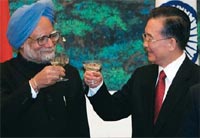Tread with care


Then, India and China (and Brazil and South Africa) have, through their unofficial “alliance” at the World Trade Organisation, successfully stymied the carefully crafted plan of the G-8 to push through a discriminatory and one-sided international trade pact that would have ensured western hegemony in economic matters.
So, obviously, there’s great mutual benefit in walking down the path of friendship and cooperation. But here, we must add caveat. Friendship and cooperation are all very fine, but they cannot be one-way streets. The Chinese leadership is playing a game of cooperation and containment with India. Even while making politically correct statements about Indo-Chinese relations, it has blocked India’s attempts to deepen its ties with the ASEAN. It has been making equivocal statements about backing India’s attempts at securing a permanent seat on the United Nations Security Council, and it is blowing hot and cold on the issue of resolving the border dispute. Further, it is trying to ring India militarily with a string of military alliances with Myanmar and Pakistan and provoking India with its aggressive stance on Bhutan and Nepal, both of which have traditionally been India’s backyards. Obviously, the rise of India as another pole in Asia is not something that fills Beijing’s elite with a lot of joy.
But India’s reaction to all these provocations has been marked with silence or a pusillanimous deference to Chinese assertions. Trade and cooperation are all very fine, but the Government of India should realise that in the real world, power respects power. Indian foreign policy must quickly adapt to the country’s changed status— it is a rising world power now, and no longer a Third World basket case, and must learn to fight in its weight class. The way forward: take a strong line on political and military issues while simultaneously pushing for stronger economic ties with the Dragon. In other words, tread with care.










